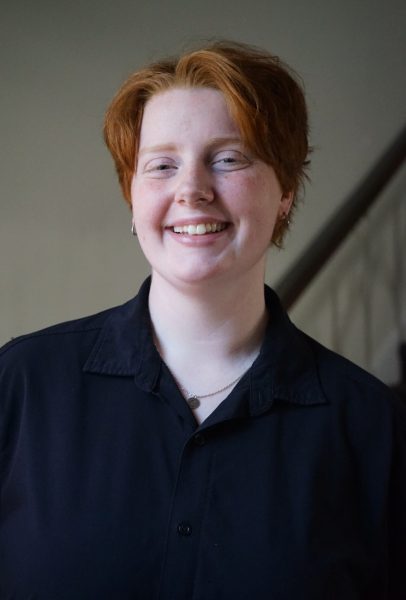Students, professor research harmonious labeling
April 13, 2023
Dr. Jared Painter and some of his students have been working on a continuous research project surrounding harmonious labeling.
Painter, who has been at the University of North Alabama since 2017, primarily does research related to modern algebras with relationships to combinatorics and graph theory.
The undergraduate research project Painter is working on began in the spring semester of 2022, when he sought to answer questions he had about a research project he led in 2019 related to graph theory. In this previous study, Painter and his students worked to generalize the results of a paper by Dr. Ken Roblee from Troy University, ending in them publishing a paper on the topic.
In 2022, when he came back to the project, Painter worked with Rebecca Morgan Tedford to generalize the problem by looking at the algebra-based results. They found that they could generalize the results in a nice way, but Painter still had questions on the subject, so in the fall of 2022, he began working with student Rachel Hill on an expansion of the project.
“We ironed out the kinks in these results and found a completely new group structure that had this property that was only known in the structures we were working with for certain conditions before,” said Painter. “If we changed or made a different addition operation, it always satisfied the properties that we wanted.”
Their discoveries in this study have led to a potential new standard when solving harmonious labeling problems.
To break the project down, Painter and his students take a graph and label every point or node on that graph with numbers between zero and a set highest value. They then seek to get an induced edge label, which labels the lines between the vertices as the sum of the two vertex labels, that is then divided by that set highest value. Upon dividing, they find the remainder, which they use to label the edge. At the end of this process, they hope to have edge labels that are all distinct, none of them repeating, which is referred to as harmonious labeling.
“It’s kind of like a hard puzzle problem,” Painter said. “There’s a lot of algebraic structure to the set that we use. We took that structure and essentially broke it down so that we could represent all the numbers in there with smaller components to see easily whether or not we got distinct elements when we added all these edge labels. Using this algebra structure, we can write every number in this set in such a way that we can piece every component of it uniquely together with different algebraic structure components. We can break it down into smaller sets, and then we know where everything is going to live, and we can also figure out how we can add two things up and uniquely represent the sum of those things.”
When working with very large sets, it is difficult and time-consuming to prove that every edge label is unique, but Painter and his students sought to break the larger sets down into smaller, more easily-digestible sets to make solving harmonious labeling problems easier.
“We basically said, with any factorization of this arbitrary number, you can represent all of the components in here using pieces of these factors,” Painter said. “It gives you a nice, compartmentalized way of working with those numbers. In terms of the real-world sense where harmonious labeling has come in, there are some notions of optimal computing pathways that relate to labeling problems. The new algebra structure that we’ve uncovered from this gives us a new way to think about operations on elements in a more efficient and compartmentalized way, which has the potential to solve a lot of other kinds of problems.”
Painter hopes to publish a paper on these findings soon. In addition to this, the students he has worked with have done presentations on the research. Hill, who worked with Painter most recently, has presented multiple times, including at the Nebraska Conference for Undergraduate Women and at Ole Miss at the Mathematical Association of America Section Meeting. She will also get to be listed as a coauthor on the paper that will be published on the research.
Hill believes that research is important to challenge ideas and expand ways of thinking.
“I think it shows you a different way you can work with sets and numbers,” said Hill. “Who would have thought you could add the different sets and get the same numbers? It’s a different way you can show how math always ends up connecting when you use different ideas.”
Painter greatly enjoys working with his students on research projects like this.
“It’s a lot of fun,” Painter said. “Sometimes it’s a struggle, but it’s a lot of fun for me because I get to have these higher-level conversations with students. Maybe they’re struggling on certain pockets of it, but once you start having them write up results on it, you really start seeing the light bulbs go off in their heads, and that’s a lot of fun.”
Hill has enjoyed getting to connect with one of her professors on a more advanced academic level.
“Typically, you sit and take notes,” Hill said. “In research, while they know more than you, you start to feel like your opinion is there more. They’re still learning like we are. It’s less intimidating.”
Painter still has many questions about the topic and would like to get more students to work with him on this research in the future.
“A lot of students get intimidated when they hear they have to do research,” Hill said. “Research doesn’t necessarily always have to be a new topic. It can be something that has been discovered, but you don’t know it. If you find anything you’re interested in in class, don’t be afraid to reach out to your professor. I can almost guarantee, someone will help you research it. Most of the time, they have a topic ready, and they’re just waiting for someone to ask them.”



